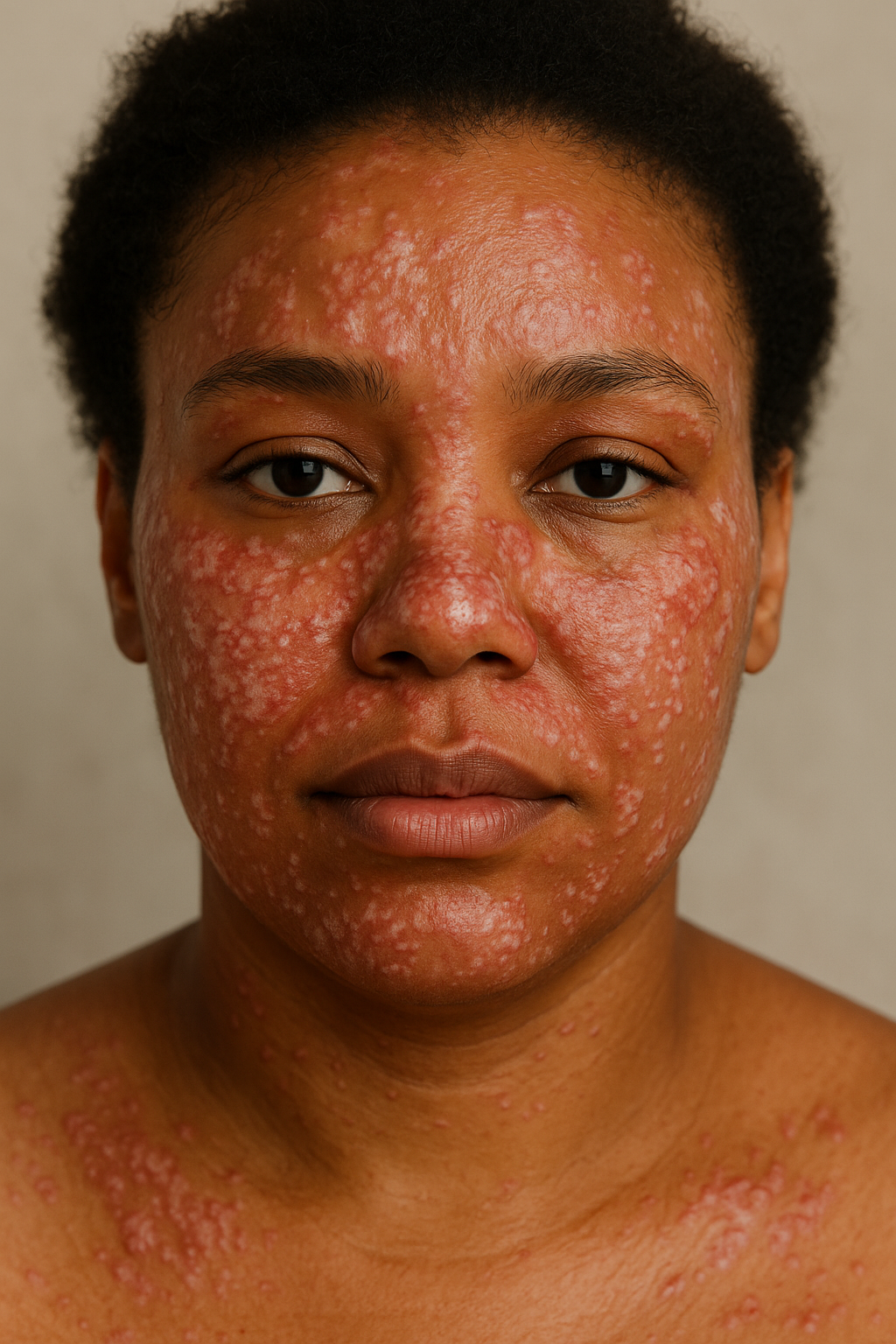When Your Immune System Throws a Tantrum: My Psoriatic Arthritis Saga
Psoriasis on Black Skin
The Glow-Up That Wasn't
In 2016, during my first pregnancy, I expected the usual pregnancy glow. Instead, my skin decided to channel its inner reptile—dry, flaky, and peeling. By 2020, post-baby number two, my face resembled a cracked desert floor. Enter COVID-19: the era of masks. While the world lamented mask mandates, I silently rejoiced. I was able to hide my flaky skin on my face, specifically around my mouth. I look like I had eaten some flaky dessert and forgot to wipe my mouth. The few people who saw it stared me down shamelessly. I was on bed rest, gained 70lbs both times, and couldn’t understand why my pregnancies were this bad or why I still felt sick after the babies came. Pregnancy is a rollercoaster of hormones and immune system shifts. For some, it's a period of remission; for others, like me, it's a trigger. The stress and hormonal changes associated with pregnancy can exacerbate or even initiate autoimmune responses.(HealthCentral)
Misdiagnosis
Doctors initially labeled my condition as rheumatoid arthritis (RA) and fibromyalgia. I embarked on a pharmaceutical journey, trying medications that promised relief but delivered side effects. It wasn't until late 2024, after years of ineffective treatments, that I received the correct diagnosis: psoriatic arthritis (PsA). Better late than never, I guess. I tried alternative therapies from diet change, RA coach ( fitness coach), herbal teas and medicines, even energy clearing, which was something I would not have done otherwise due to my Christian beliefs. I just wanted a break from this hell.
Uncommon Symptoms of Psoriatic Arthritis
While joint pain and skin lesions are hallmark features of PsA, the disease can manifest in various unexpected ways:
Eye Issues: PsA can lead to eye problems such as conjunctivitis, dry eye syndrome, scleritis, and uveitis. Uveitis, in particular, affects about 7% to 25% of those with PsA and can cause pain, redness, irritation, and disturbed vision, potentially leading to permanent vision loss. Arthritis Foundation
Spinal and Neck Pain: Approximately 40% of PsA patients experience pain in the spine due to inflammation in the joints between the vertebrae (psoriatic spondylitis) or between the spine and pelvis (sacroiliitis).
Arthritis Mutilans: A severe form of PsA affecting about 5% of patients, leading to joint erosion and shortening, particularly in the hands and feet, causing permanent damage.
Mental Health Challenges: One in five PsA patients contends with mood disorders, including anxiety and depression, often due to chronic pain and visible skin problems.
Fatigue: Severe fatigue is present in approximately 30% of PsA patients, described as extreme exhaustion that does not go away with adequate rest.
Nail Changes: PsA can cause nail symptoms like discoloration, pitting, or separation from the nail beds.
Skin Sensations: Some individuals report a crawling sensation on their skin, known as formication, which can be particularly distressing.
Rib Cartilage Pain: Pain in the rib cartilage, sometimes described as "charlie horses" in the ribs, has been reported by PsA patients.
Insights from Popular Health Articles
A notable article from SELF magazine highlights that PsA symptoms can extend beyond joints and skin, affecting areas like the eyes, heart, gut, lungs, and other organs. It emphasizes the importance of recognizing these systemic manifestations for timely diagnosis and treatment.SELF
The Rare Subtype—Palmoplantar Pustulosis
As if PsA wasn't enough, I hit the jackpot with a rare subtype: palmoplantar pustulosis (PPP). This condition graces the palms and soles with painful pustules, making everyday tasks a challenge. PPP is notoriously stubborn, often resisting standard treatments. I went to a dermatologist who casually said it was just dryness. Like What!? This was clearly not the case. I found another creator who had the same issues I had, and she gave me the name for it, which later was confirmed by a rheumatologist.
Beyond Skin and Bones
PsA doesn't stop at joints and skin. It can also affect the eyes (uveitis), gastrointestinal tract (inflammatory bowel disease), and cardiovascular system. Moreover, the chronic pain and visible skin symptoms can lead to significant mental health challenges, such as depression and anxiety .
The Mental Toll
Living with PsA isn't just a physical battle; it's a mental one. The unpredictability of flare-ups, combined with chronic pain, can lead to feelings of frustration, isolation, and depression. It's essential to address mental health alongside physical symptoms. (Medical News Today). I started intense therapy and got all the treatment I could get to keep myself sane. I also used a lot of the built-up frustration to start painting, which turned out to be a hidden talent I had been sitting on, something good for once.
Moving Forward
Receiving the correct diagnosis in 2024 was a turning point. With appropriate treatment, including medications targeting specific inflammatory pathways, I've experienced significant improvement. While PsA is a chronic condition, understanding its complexities and receiving proper care has made a world of difference in managing my health and well-being.(self.com)
